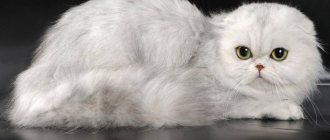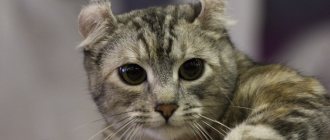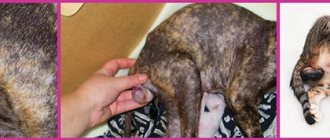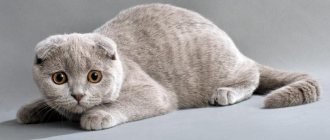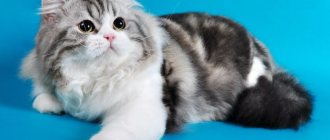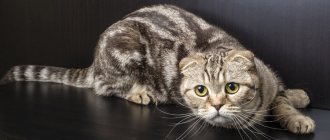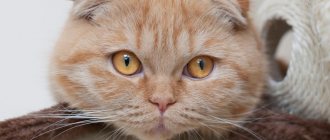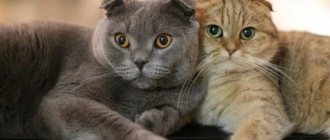What does a Scottish fold cat look like?
Even a child can tell what a Scottish fold cat looks like, since the breed is very popular these days. This is an animal of a strong build with a round head on which small cute ears are located. In the photo of a Scottish fold cat you can see that in some individuals the ears are pressed tightly against the head and are almost invisible, while in other cats the ears are clearly visible.
Muzzle
The youth of the Scottish Fold breed means that they have not participated in international shows or shows very often.
The main criterion for the appearance of a Scottish Fold is full compliance with the requirements of the breed standard. The animal's head is rounded, with a powerful chin, fleshy cheeks and an open forehead. Adults may have slight sagging of the cheeks. The nose is quite wide and short, fully pigmented.
Ears
Unusual ears come in small or medium sizes. The tips are slightly pointed. The ears are set wide apart and bend strongly forward and then down. According to the standard, they should be pressed and not protrude beyond the head. Breeders name three types of ears:
- single, in which only the ends are bent;
- double, when the entire shell is bent, but the gap between it and the head is clearly visible;
- triple, with ears completely laid back.
The owner himself chooses which type to give preference to.
Eyes
The eyes of cats have a round cut, they are widely spaced. The color of the irises should match the main color of the pet.
Neck
The Scottish Fold's neck is short and strongly muscled.
Body type
Scottish cats have a strong, fairly muscular body of medium size. The shoulder part, as well as the chest, are well developed.
The weight of a cat can vary from 3 kg to 6 kg, and the height at the withers reaches 28-32 cm. Males are slightly larger than females.
Limbs
Animals' paws are small and round in shape. The hind and forelimbs are of medium length with highly developed muscles.
Tail
The tail of seals is very flexible, mobile, slightly wide at the very base, gradually narrowing. The tip is slightly rounded.
Coat and color
The Scots coat is very dense and thick. The hair of a healthy animal is elastic and has a natural shine in the sun. The high density does not allow the fur to adhere to the body, so the cat looks very fluffy.
The Fold breed has a wide variety of coat colors. Solid colors are widespread:
- white – a snow-white shade with a silver sheen, blue eyes, pink nose and paw pads;
- black with amber eyes, black or dark brown pads;
- blue, closer to gray, without any transitions, the pet’s eyes are light brown, paw pads and nose are gray;
- red or deep red with bright golden eyes, brick-colored nose and pads;
- cream, represented by a light palette of gray or beige, yellow eyes.
Breeders are interested in the combined color types of the Scottish Fold cat, which are obtained by combining the color of the main coat with the undercoat:
- chinchilla, or silver, in which the top of the body, head and tail are painted black, and the undercoat is light;
- smoke, with a light undercoat and a tortoiseshell or blue topcoat;
- shaded, when the tips and undercoat are almost white or cream, but the ticking can be one of the main colors;
- Shell Cameo, or red chinchilla, with a white undercoat and red or tan ticking.
There is also a tortoiseshell pattern, in which the color is formed by spots of cream, black and red.
Varieties of Scottish Fold cats are distinguished by the shape and size of their ears, but not by their colors.
The requirements are also strict regarding the combination of eye color and fur shade of the cat. For example, chinchillas are not allowed to have a hazel eye tint.
| Color type | Eye color | Coat color |
| plain | amber (gold) |
|
| blue or heterochromia | white | |
| Shaded | amber (gold) |
|
| green |
| |
| blue-green | silver | |
| Chinchilla | green or blue-green | silver |
| amber (gold) | red | |
| Tabby | amber (gold) |
|
| copper |
| |
| green/walnut | silver tabby | |
| Cameo (chintz) | amber | |
| Bicolor (two-color) | amber, blue or heterochromia | |
| Points | blue or dark blue | all sorts of variations |
Personality of the Scottish Fold cat
Representatives of Scottish Folds are characterized by attachment not only to their place of residence, but also to their owner. This is justified by the fact that initially they were bred solely for the purpose of keeping them at home, without the possibility of walking.
Indeed, pets do not experience discomfort from living in city apartments. However, keeping in country houses with its own area where the cat can walk is also acceptable for this breed.
By temperament, Scottish pets are phlegmatic. They are patient, moderately affectionate, and try not to get into conflicts. However, cowardice is not characteristic of them, so animals can safely stand up for themselves.
How to get along with children
The fold-eared cat gets along well in families with small children. She will try not to fall into the arms of the baby. However, even in case of excessive caresses, it will not scratch or bite the child.
How does he get along with other animals?
The Scottish Fold will find a common language with other pets, although he clearly does not like dogs or rodents. The character of the Scottish Fold cat is not aggressive or has a high hunting instinct, but other animals may seem like competitors to them, and they will become jealous.
How to get along with adults
The beauty and grace of the cat are combined with a sharp mind. She knows when to approach a person to receive a portion of affection. At the same time, the animal will not impose itself or climb into your arms. Folds stand on their hind legs like columns for a very long time and sleep nicely on their backs. This made them popular as models for photo shoots.
Character of Scottish folds
While most cat breeds get used to their place of permanent residence, Scottish Folds, like dogs, also become attached to their owner.
This is explained by the fact that the breed was originally bred as a domestic dog. Fold cats have never lived in a semi-wild state, so attachment to humans is inherent in them at the genetic level.
The Scottish Fold can be kept perfectly in a city apartment. She is not drawn to walks in the fresh air, although they will not bother her. If the owners periodically take the Folds out to the dacha, they will not cause them any disturbance: the cat will stay close to the owner all the time, not trying to run away.
When buying a kitten of this breed, you should immediately understand that Scottish Folds are very attached to their owner and are very impressionable. Various unexpected changes may come as a shock to them:
- rearrangement of furniture in the apartment, which representatives of all cat breeds do not like;
- long absence of the owner;
- owner's inattention.
They experience loneliness very much, as well as physical pain. Because of this, they may become depressed. Small kittens and teenage cats are especially sensitive to human attention. They need daily positive communication with their owner, otherwise the animal may get sick.
Representatives of this breed have a calm and balanced character. Folds are distinguished by their patience and affectionate attitude towards people. Sometimes you can notice a certain phlegmatic nature in their character.
Aggressive behavior is not considered a breed trait. Scottish folds never clash, which is why some people consider them cowardly. In fact, this is a breed character trait.
Representatives of this breed are true gentlemen. They prefer not to notice the one who initiates the conflict. If a difficult situation arises, the Scottish Fold cat can always fight back the offender.
This breed is suitable for families with small children. Fold will never scratch a child if the baby pesters him and squeezes him in his hands. A cat of this breed will delicately try to move away from the child instead of fighting back.
Scottish Folds get along well with dogs and even rodents, although they will still have hunting instincts. At the most unexpected moment, this animal, which at times seems passive and slow, likes to stretch its legs. To do this, he needs to build a special “sports corner” where the Scottish Fold can stretch his muscles.
A feature of this breed is practicality, which is rarely seen in representatives of other cat breeds. Fold-eared individuals can distinguish information that comes to them from the outside world and use it to their advantage. This feature of mentality and character makes Scottish Folds highly trainable.
A characteristic feature of the breed, for which it is called voiceless, is the peculiar sound that the Scottish Fold makes. Their voice sounds more like a squeak than a traditional meow.
A Scottish Fold cat will decorate any home. She is distinguished by her beauty and grace. At a young age, all individuals are playful. Adult cats are sedate and calm, with a sense of real aristocracy.
Cats of this breed love to stand in a column position on their hind legs and sleep on their backs, which generates a lot of affection from all people. A muzzle with an owl's gaze leaves no one indifferent and gives a lot of positive emotions.
Cats of this breed fit perfectly into large families and become faithful companions to lonely people. Representatives of this breed especially appreciate the attention and care of a person, paying him in return with affection and love.
Raising a Scottish Fold cat
Despite its cute appearance, the Scottish Fold considers itself a full-fledged member of the family. Like a child, she must be raised from the first day in the house. Considering that kittens of this breed are very smart, training will not be so difficult.
The future owner must understand the habits of Scottish cats in order to properly adjust the process of accustoming them to the rules of living in a family. Thus, Scottish Folds do not tolerate loneliness quite well. You shouldn't leave them alone for a long time. As soon as the baby gets enough sleep, he will begin to look for entertainment. Therefore, scattered small objects, broken vases, and chewed wires await the owner after a long absence.
The pet will want to spend a lot of time in the arms of its beloved owner or next to him. Moreover, he sits not only on his lap, but also on the table in front of the computer or on the bed. If it seems cute to a baby, then an adult cat is already starting to irritate. Therefore, it is important to teach your cat not to climb onto objects that are not intended for this purpose.
How to act correctly in a situation when a pet is wrong depends on the owner. The main thing is not to shout, chase away or even beat the animal. You can take five to ten minutes to communicate with him, play, throw a ball. Before going to bed, dedicate 15 minutes to your cat and keep him busy playing. This will reduce the risk of being woken up at night.
The mother's upbringing of the baby is quite strict, so it is necessary to firmly stop his pranks and wean him from bad habits. However, you shouldn’t poke a fold-eared dog with your nose. Animals remember insults for a long time and will find an opportunity to take revenge.
It is the owner’s responsibility to accustom the pet to using a scratching post and litter tray. The little Scotsman is taken to these places whenever possible and praised for correct behavior.
In any case, the main thing in raising a baby is the love, patience and perseverance of the owner.
Toilet training
Scottish Folds are cats with high intelligence, but this does not mean that they do not need to be raised from childhood and not trained to use a litter tray.
Until 3 weeks of age, kittens go to the toilet with the help of their mother cat, who licks their anus and massages their tummy with her tongue. In the future, when the baby moves around the house on his own, he will see where his mother goes to the toilet and will begin to repeat after her.
But you shouldn’t place much hope on the cat: the new owner needs to make an effort to train the kitten to use the toilet, since at first it is difficult for him to endure, and he relieves himself wherever he has to.
On average, a kitten learns to use a litter box in a new home from 2 to 7 days. It’s better to immediately purchase a litter box: this way your pet will feel comfortable and safe. Take a toilet model “for growth”, as the kitten will grow up and no longer fit inside the structure, and getting used to the new potty may take a while.
Any litter will do, but Scottish owners most often buy clay litter - it reminds cats of soil where they can bury their deeds. To find out which litter is right for your animal, buy a small quantity of each type and observe the kitten’s reaction.
There is no need to scold the baby and poke his nose into a puddle if he went to the wrong place - this can provoke stress and fear of going to the toilet. It is better to remove the urine with a napkin, wipe the area with a weak bite solution or a special product that repels cats with its smell. If a four-legged dog smells its urine in a certain place, it will continue to go there.
If your baby persistently does not want to go to the litter box, he may not like the place where he is standing. Try moving the potty to where it will be more convenient for the kitten to use it.
MYTH 5: These cats are not very active and not talkative.
Scottish cats are considered to be passive, lazy and calm. In fact, there is a huge space of options. My cat periodically rushes around the house with purrs, jumps on the backs of chairs, and climbs soft objects with the help of her claws. Sometimes he tries to do this at night. And he constantly says something. Not to the same extent as the Bengals, but still. Sometimes talkativeness can be very tiring because the cat comments on everything she does. And he pesters you, pesters you and asks for something.
In general, the cat is hyperactive. Yes, not all Scots are like that. Our second cat is calm. In most cases, when childhood and adolescence pass, the Scots calm down. But even then, among them one can distinguish both active and passive, talkative and silent. Fortunately, this tendency is easy to notice even in a small kitten and choose one that is calmer or, conversely, more playful.
Video of a Scottish cat saying “kwa”. Getting cats of this breed to talk is a piece of cake.
Scottish Fold cat health
Possible diseases
According to reviews from owners, the health of the Scottish Fold cat is strong and stable. Among them there are long-livers who have crossed the threshold of 15 years.
However, there are some health considerations that you should pay attention to. First of all, these are problems with the musculoskeletal system. The pride of the Scots - drooping ears - is the result of a mutation in cartilage tissue, so the animal’s joints are also at risk. Symptoms of arthritis may occur, affecting the general condition of the pet. A balanced diet and taking vitamin complexes prescribed by a veterinarian will help prevent this disease.
Due to an improper diet, the lop-eared pet is susceptible to food allergies and obesity. The latter leads to serious problems in the functioning of the heart, sometimes not amenable to any treatment.
The characteristic structure of an animal's eyes affects their numerous diseases. Taking care of them and promptly contacting a veterinary clinic if a problem is detected will help your cat maintain a clear outlook for many years.
What other diseases should you be wary of:
- Degenerative joint disease
. The main symptom of the disease is pain in the cat’s tail. The animal becomes lethargic and may begin to limp. Also, the pet does not jump, has difficulty getting to its feet, and licks its paws too often. The disease also affects the cat’s mood: it can become irritable and even aggressive. You can treat your cat with non-steroidal drugs. If the disease has become advanced, then only antibiotics will help. You must adhere to a special diet prescribed by your veterinarian.
- Osteochondrodysplasia
. Because of this disease, the skeleton and individual bones of the cat are damaged. The animal either limps or stops doing so, and its gait may change. The cat takes on a depressed and apathetic appearance, and its hind legs begin to deform. As with the previous disease, the cat develops pain in the tail. Self-medication is dangerous: you need to seek veterinary help as soon as possible.
- Hypertrophic cardiomyopathy
. This insidious disease often affects fold-eared cats. The disease provokes thickening of the wall, usually of the left ventricle and intergastric septum. The normal functioning of the heart muscle is disrupted. The animal may begin to breathe frequently and heavily - with wheezing and gurgling. The mucous membranes take on a bluish color, the hind limbs become paralyzed, and the pet may faint.
Sometimes the disease occurs without external symptoms, which is why it is necessary to regularly visit the veterinarian after the cat is 5 years old.
Vaccinations
Important for your pet’s health is routine vaccination, which will protect against a large number of viral diseases: distemper, hepatitis, rabies, enteritis, parainfluenza, calcivirosis and others. Vaccinations are scheduled at least once a year.
Reproductive health
Individuals of the Scottish breed fully mature by the age of one and a half years. At this age, animals are mated. A healthy female goes through pregnancy without problems and usually gives birth to 4-5 kittens. The birth should be supervised so that if there are problems, help can be provided quickly.
If the owners do not plan to procreate their pets, then they need to think about the procedure of castration or sterilization. Operations are performed on one-year-old representatives of the breed.
How to choose a Scottish kitten
You should look for a kitten of this breed in specialized nurseries that deal with this breed. Many have their own websites or pages on social networks
When choosing a kitten, you need to pay special attention to its appearance and health. Kittens that do not have health problems should be active and have soft fluffy fur.
The animal's eyes should not water. A lethargic kitten is a sign of health problems. If an animal is purchased from a nursery, it is recommended to look at its parents in order to roughly imagine its appearance in adulthood. You must ask for a veterinary passport with vaccination records and the kitten's pedigree, which lists all its ancestors.
Prices for Scottish fold kittens range from 10,000 to 40,000 rubles. It is worth knowing that animals with long hair are approximately twice as valuable as their short-haired counterparts.
The main criteria to pay attention to are:
- wool that looks like plush;
- ears should be close to the head;
- kitten color;
- Scottish Folds must have short hair;
- highland fold – long;
- blue eyes, but their color changes with age;
- The height of a three-month-old kitten is about 500 grams and its height is approximately 15 cm.
All these criteria indicate the health and purebred of a kitten of this breed.
What affects life expectancy
Genetics is the main factor that influences the lifespan of a fold-eared cat. Since the breed was bred artificially, it is susceptible to some of the above diseases. Therefore, when purchasing a kitten, it is important to study the veterinary passport, information about the parents and their illnesses.
If the “Scot” does not move enough, she will become obese, which will shorten her life by 3-4 years. In this case, you need to ensure that the animal does not fall from a great height and is not injured - this can cause problems with the skeleton and cartilage tissue.
Here are a few more parameters that affect a cat’s lifespan:
- nutrition: if you don’t take care of it and feed the cat anything, its immunity will weaken and its health will worsen;
- coat care: it is important to regularly comb Scots, especially long-haired ones, since when licking they swallow their own hair, which clogs the passages and forms lumps in the stomach;
- Malt paste will help in the fight against the removal of wool mats from the stomach;
- Ear care: the owner needs to take special care of the ears of a fold-eared cat - they are more susceptible than straight-eared cats to otitis media, accumulation of earwax and other diseases.
Good care and following some recommendations will help prolong the life of your beloved cat.
How to make a pet long-lived
The following will help extend the life of a fold-eared cat:
- Timely vaccination. Even if a cat does not walk outside, it still needs to be vaccinated - this is the only way to protect it from various diseases.
- Proper nutrition. If an animal eats “store-bought” food, then it must be at least premium. Natural food should be rich in protein.
- Care. Hygiene and keeping the animal clean will have a beneficial effect not only on its appearance, but also on its health.
- Regular examination by a veterinarian. Ideally, you should conduct a routine examination of your pet once every 6 months. The specialist will check the general health of the cat and may even identify the beginnings of a disease that needs to be treated as soon as possible.
- Exercise stress. Let your pet run, jump, play and enjoy life. But at the same time, make sure that the cat does not get injured.
- Castration and sterilization. Animals that undergo this procedure live 2-3 years longer than their counterparts.
Of course, like any living creature, cats do not tolerate stress well. It is advisable to protect your pet from scandals, noisy parties and too frequent trips anywhere.
Interesting Facts
– All Scottish Fold kittens are born with straight ears; they droop after three to four weeks.
– All fold-eared cats have ears that hang differently; it is believed that the more tightly the ears are pressed down and the smaller they are, the better.
– Not all kittens have drooping ears; some of them remain erect; such cats are called straight cats. They retain all other characteristics of the breed, except for the position of the ears.
– Scottish fold cats cannot exist on their own; for breeding they definitely need straight cats, cats or cats in which the gene responsible for the development of bone and cartilage tissue is not damaged. Straights do not take part in exhibitions, they are used only for breeding. Crossing a Fold with a Fold is prohibited, as kittens may be born with serious defects, mutations, deformities or be non-viable.
– Scottish Folds are still not recognized by the international European cat breeding federation FIFE.
Features of feeding and diet
Only a properly formulated diet can become the basis for a pet’s healthy lifestyle. Before purchasing a kitten, you need to find out what kind of food it was fed, and then gradually transfer it to a diet convenient for the owner.
Due to the tendency to overeat, and as a result - to obesity, the frequency of feeding and portion size are strictly observed. From 1 month to six months, a kitten is fed at least 4 times a day; from 6 months, feeding is reduced to 3 times, and from 1 year of life, twice feeding is sufficient.
You cannot treat your lop-eared pet with food from the owner's table. It can cause food allergies due to the abundance of flavoring additives, preservatives and substances that are not absorbed by the cat’s body.
There are three feeding options for the Scottish Fold:
- natural food;
- ready-made industrial feed;
- combined diet.
Each of them has the right to life, and the owner chooses the one that he and his pet like.
Natural nutrition
Preferring a natural menu, it is important to remember the need to combine all the components in it for the proper development of the animal. So, from the age of one month, the kitten begins to be fed. This is usually done in the nursery. Kittens are offered low-fat fermented milk products and boiled chicken eggs.
Gradually, the diet is diversified with low-fat meat products. Thus, lamb, rabbit, chicken, and beef become the main products not only for teenage cats, but also for adult cats.
It is useful to combine meat with various cereals or vegetables. The preferred porridges are buckwheat, rice or oatmeal. Vegetables are added both raw and boiled.
A little vegetable oil added to food will help keep the coat shiny for a long time. Sometimes it’s worth pampering a Scot with boiled boneless sea fish or organ meats.
It would not be a bad idea to add mineral and vitamin complexes to animal food, but which ones and in what quantities can only be determined by a veterinarian. For example, unauthorized administration of calcium to a representative of the fold-eared breed can lead to a violation of the correct fit of the ears according to the standards.
Industrial feed
Premium dry food and higher are already rich in nutrients. Industrial food also includes wet food, which is alternated with dry food. The convenience of this type of food is that it is stored for a long time and does not require time-consuming preparation.
Combination
In combination feeding, both types of feeding are used to create the cat's menu. The main rule to follow is not to mix natural food and ready-made food at one time. If you have sensitive digestion or are elderly, it is better to avoid the combination.
With any feeding option, we must not forget about clean water available to the pet at any time.
Care and maintenance
Cats of this breed are quite capricious, so caring for and maintaining a Scottish Fold cat poses certain difficulties for the owner.
Grooming
Special care is required for your pet's coat. Once a week, brush it with a soft natural bristle brush designed for short-haired individuals. In spring and autumn, during shedding, fallen hairs are carefully removed twice or thrice a week.
Bathing
Bath the animal no more than once a month. However, if a cat is preparing to participate in an exhibition, then it must be bathed using not only a special shampoo, but also conditioner to make the Scots coat shine.
Caring for your ears, eyes and nose
It is recommended to treat cats' ears with special solutions to remove dirt and dust. It is important not to try to penetrate deep into the ear, so as not to harm or injure the cat.
Wipe the eyes with a cotton pad to remove any secretions. For minor inflammations, chamomile infusion or syntomycin ointment helps.
It is important to keep the nose clean and clean it regularly, especially if the cat has recently had a cold or does not know how to eat carefully. You can clean your nose with a cotton swab dipped in water, but you need to be careful: cats usually don’t like the procedure.
Nail hygiene
Nails are trimmed starting in early childhood. A pet accustomed to manicure will not perceive the procedure as a punishment. You should cut off no more than 2 mm from the tip of the nail plate with a special nail clipper, and then use a rough nail file to handle the irregularities.
Walk
It is better for fold-eared cats to walk under the supervision of the owner and on a leash, so as not to run away and become a victim of stray dogs, other cats and cars.
First, you need to accustom the cat to the collar: let him walk around with it for several hours, or even days. When the collar is perceived calmly by the animal, you can attach a leash to it. The cat walks around the apartment a little, and then you take the leash in your hand and try to control the pet so that it goes where you want.
If your cat resists the collar and categorically refuses to wear it, try walking with a harness. This device is more convenient, and the cat will not slip out of it.
Remember that you need to let your pet outside only after vaccination and the end of quarantine, otherwise the cat may catch some kind of infection. Also, a walking cat needs to be wormed once a quarter.
The first walks are best done in the evening and in quiet places where there are no cars, people or dogs. It will be ideal if another family member goes with you: the cat will be calmer next to people they know well.
Castration and sterilization
If the owner of the “Scottish” is not a breeder and does not plan to continue the cat’s family, then the animal must be castrated or sterilized. If this is not done, your pet may develop oncology or diseases of the genitourinary system. There are also inconveniences for the owner: an uncastrated male marks the territory, and the female may become uncontrollable during her “critical days.”
You should not perform the operation while your pet is still small: this will have a detrimental effect on his health and development. But if you miss the moment and castrate an already adult cat, then the habit of marking territory may remain.
The ideal age for surgery is 10-12 months, when the animal is already fully formed, but does not yet experience a strong sexual desire and does not demonstrate behavioral problems. Some owners castrate cats when they are six months old, but for Scottish Folds this is too early.
Do not delay the operation until 3 years, after this period there is a high risk of complications and difficulty in enduring general anesthesia. After the operation, the clinic may ask you to leave the cat for 3-4 hours: do not refuse this, specialists will monitor the animal’s condition after anesthesia.
You need to pick up your pet in a comfortable carrier with a hard bottom so that it does not feel discomfort, and go home only by private car or taxi - but not by public transport. Place a disposable diaper at the bottom of the carrier, and if it’s winter outside, cover the cat with a light blanket.
When you arrive home, do not place your cat on the bed: it may fall off it. Place your pet only on the floor, but not naked - take a soft bedding or mattress. Make sure that the room is free from cold and drafts, but you don’t need too high a temperature either.
Be sure to purchase a special blanket that covers the stitches on the abdomen (if the operation was performed on the female using a non-laparoscopic method). The animal may lick the seams and they will come apart.
Most often, experts prohibit feeding cats on the day of surgery to prevent them from vomiting during the effects of anesthesia. Food is served the next day in liquid form. The doctor will also prescribe treatment of sutures or antibiotic injections - the latter happens extremely rarely.
The stitches are removed after about 1-2 weeks. If there was a laparoscopy, the tiny sutures will dissolve on their own.
Breeding Scottish Fold cats
You cannot breed animals without proper education or at least experience, since breeding selection, mating, pregnancy and childbirth can be very difficult, and you must be mentally and financially prepared for this.
"Scots" reach sexual maturity by 9-10 months, but you should not breed a pet at this age - it is better to wait until 18 months. During the female's first heat (usually at one year of age), it is also better not to mate her with a male, but wait at least until the second or third heat. Early pregnancy negatively affects the health of a young mother and her babies.
The choice of the male is of great importance: after all, what the offspring will look like and what health the young animals will have depends on him.
Remember that you cannot breed a fold-eared cat with a fold-eared cat. One of the parents must be a straight-eared Scot. If both parents are lop-eared, the offspring will be unviable, with many defects.
Mating is carried out with an experienced male and on his territory. The cat is brought to the cat on the second day of estrus and left for 2-3 days. Be prepared that the female may not become pregnant right away - this is not a big deal, try again the next time she is in heat.
The pregnancy of a fold cat lasts approximately 65 days. Moreover, if labor began 1-2 days earlier, this is normal. But if it is 5 days earlier, then the babies most likely will not survive.
The mother's birth should take place in a calm and quiet environment. It is better to place the cat in a box or closet, after laying a soft bed or blanket there. It is important that the animal can calmly get out of the box without jumping high.
If the pregnancy itself is relatively easy for a fold-eared cat, then it is better to invite a specialist for childbirth. Sometimes lop ears require a caesarean section.
Tips for choosing a kitten
You need to approach the purchase of a Scottish Fold cat very responsibly. Only if the future owner has enough time to care for the pet can he start choosing a baby.
Experienced breeders recommend adopting a kitten no younger than 11-13 weeks of age. Then he will have time to develop good immunity thanks to feeding with mother's milk, and will also develop the necessary skills for using a tray and feeding himself.
It is worth paying attention to the characteristic lop ears of the animal. It would be wrong to buy a kitten on the market or secondhand without the appropriate documents. There will be no guarantee that this is really a fold-eared breed and not a small mutant of another individual.
When observing Scottish Fold kittens in a specialized nursery, be sure to take a closer look at their behavior. It is advised to choose active animals with shiny, smooth fur. Their eyes and ears should be clean, without signs of inflammation.
Be sure to ask about your pet’s veterinary passport, check the details of the first comprehensive vaccination and rabies vaccination. Find out the last date for treatment for intestinal parasites.
Kitten care
Caring for Scottish Fold kittens is easy. The coat does not require special care; it is enough to comb it once a week; it is enough to wash the eyes once every 5-7 days.
The only thing worth paying attention to is ear care. This issue should be treated with the utmost care.
It is the ears that are the calling card of this cat breed, but at the same time they are also a weak point.
Eye examination and cleaning
If your eyes are healthy, then there is no special need for rinsing, you just need to keep them clean. But if the eyes are inflamed, they should be washed 2-3 times a day; this can be done with plain water, a weak chamomile solution or a medicated solution. To do this, you should use a cotton swab or soft cloth. If the inflammation lasts more than a week, then you need to consult a specialist.
Ear cleaning
This procedure should be done two to three (more often) times a month. To clean, use a cotton swab slightly moistened with a special liquid. The procedure must be carried out carefully so as not to damage the auricle.
The presence of a thin brown crust in the ears is an alarming sign; it indicates the presence of ear mites. In this case, you cannot do without a visit to the veterinarian. The treatment will be long with the help of a special solution. If measures are taken in time, the prognosis is favorable.
Grooming
To keep your Scottish Fold kitten beautiful and well-groomed, you need to take care of its fur; it’s not at all difficult. To properly care for the coat, you should use a special brush or silicone glove. During the shedding period, it is recommended to comb it once a week, the rest of the time once every two weeks will be enough.
While at the dacha, you should pay special attention to this procedure, carefully examine the animal every day for ticks and other parasites.
Bathing, washing
Scottish fold kittens must be accustomed to water procedures from childhood. To do this, you need to gradually moisten them with a damp towel, and then give your pet a treat so that he develops a reflex that a bath is not scary. In the future, you can safely wash the kitten. Particularly active kittens are recommended to be protected in a special way before taking a bath. To do this, cover your ears with tampons. or you can simply cover them with your hands to prevent water from entering. Your eyes also need protection; you can even drip special protective oil into them, but this is not necessary.
When washing your Scottish Fold kitten, be sure to use cat shampoo, and then its coat will be healthy and shiny. The products are not suitable for humans, they will cause skin irritation and worsen the condition of the coat; in severe cases, dermatitis is possible.
Nail trimming
Very sharp, thin claws of a kitten should be trimmed with special clippers for small animals.
The advantage of such a tool is that they give a straight cut without splitting the claw - this is very important! When caring for a kitten's claws, only the very tip is removed. Under no circumstances should you damage a blood vessel, this will cause severe pain and can lead to the most negative consequences.
In this case, a simple rule applies: it is better to cut off too little than too much.
How to prepare for the arrival of a kitten
“Scots” are very playful and active, and also incredibly curious, so before bringing the kitten into the house, remove all potentially dangerous objects (poisonous plants, wires, small things that the animal can swallow, glass accessories, etc.). ).
When the baby is in the apartment, give him time to get comfortable: leave him in a quiet place and do not disturb him. Let the kitten explore the room itself and get used to it. Don't rush him or pick him up until he gets the hang of it. Do not place the animal on a slippery surface (linoleum, tiles, laminate): this will make it feel uncomfortable.
Before getting a kitten, be sure to purchase:
- bowls;
- tray and filler;
- carrying;
- a set of absorbent diapers;
- bed or house;
- nail clipper;
- scratching post;
- toys.
You will be given several portions of food at the nursery. For the first month, feed your baby this particular product, and then you can gradually switch him to another food or natural food.
When the kitten gets used to it, you can start to slowly get to know it, play, pet it so that it gets used to human hands. You can invite other people into the house and allow the baby to communicate with them so that he grows up fearless and socialized.
What to name a Scottish Fold kitten
“Scots” are usually bred in nurseries, where the babies receive a name at birth. It is recorded in a special passport - metrics. But more often than not, the kitten’s name is too long and sounds official, so owners come up with new names for their cats.
It’s good if the nickname contains the sounds “zh”, “z”, “s”, “ch”, “sh”, “sch”, because cats react to them more readily. But even without them, the pet will learn its name. Some individuals have two completely different nicknames and respond equally well to both.
Most often, owners focus on the color of their pet when choosing a name: Ash, Smoke, Fog, Smokey, Gray, Gold, Cinnamon, Soot, Fanta, Vanilla, Salt, Apricot, Yolk, Pearl, Sugar, Tiger, Coal.
It’s not bad if you choose a name for your pet depending on its character: Egoza, Kusaka, Mila, Dushka, Puma, Sonya, Buyan, Rogue, Milash, Scratch, Shustrik, Schumacher.
It is not necessary to focus on the kitten itself when choosing a name - you can simply choose a beautiful and euphonious nickname: Topaz, Charles, Agate, Cupid, Mark, Hermes, Tim, Sky, Fiona, Freya, Lily, Diva, Chloe, Athena, Rose.
Such funny nicknames sound very touching and funny: Cheesecake, Korzhik, Pate, Cupcake, Buttercup, Gnome, Squirrel, Pug, Waffle, Washer, Simka, Flashka.
How much does a Scottish fold cat cost?
The price of a Scottish fold cat depends, first of all, on the class of the pet. Show-class cats will cost more than others - they must have a good pedigree and have high exhibition qualities.
Animals of the breed class are suitable for breeding. They may have only minor deviations from the standards: slightly fitting ears, different eye color. Pet class kittens are considered the cheapest. It is these individuals that will make wonderful pets.
Thus, the cost of animals varies from 15,000 to 60,000 rubles.
Health
Genetically, fold-eared cats have many problems. This does not mean, of course, that all of them will manifest themselves in your pet. But forewarned is forearmed!
The first thing that the future owner of a Scottish Fold cat should know about is the skeletal anomalies characteristic of fold cats. The same gene that determines lop ears is responsible for them, so this problem is common.
Osteochondrodysplasia is a hereditary disease that is expressed in skeletal deformation, immobility and pain in the tail, and deformation of the paws. Osteochondrodysplasia, unfortunately, can manifest itself at any age - both in infancy and in the prime of life.
External signs of the disease:
- lameness;
- stiff gait;
- reluctance to jump;
- acute reaction to touching the tail;
- unexpectedly squat appearance of the animal.
To avoid this disease, fold+fold mating should be strictly avoided. Most often, it is the offspring of such parents who are born with a disorder of the musculoskeletal system. It is also worth noting the tendency of representatives of this breed to heart diseases.
Timely vaccinations, visits to the doctor, regular joint examinations, x-rays and proper preventive treatment will help maintain the quality of life of your Scottish. The average life expectancy of these cats is 10-15 years.



